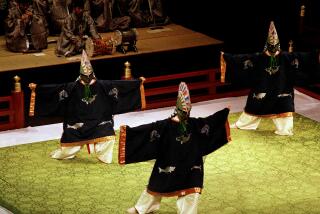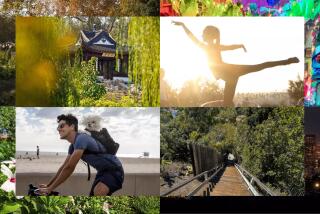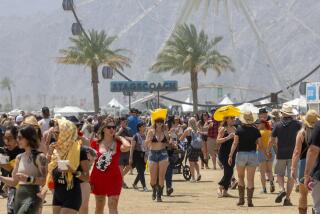MUSIC & DANCE NEWS : Hit the Road, Visit a Festival
Summertime is music festival time, and California plays host to a handful of famous events.
The one closest to home, the Ojai Music Festival, kicks off the season in early June, but if you missed it last weekend, don’t despair. A little more driving and there’s still plenty of high-quality music up and down the coast, and even inland.
La Jolla’s SummerFest, the summer arm of the La Jolla Chamber Music Society, runs Aug. 11-27. Brainchild of conductor-director Heiichiro Ohyama, SummerFest this year has its usual emphasis on the classics, with oboist Allan Vogel, violinist Cho-Liang Lin and cellist Carter Brey among the two-dozen-plus visiting artists.
What will be new and different this summer is a mini-jazz series of two concerts that “will showcase artists that we feel are of the same high caliber that we demand of our chamber music artists,” says SummerFest general manager Linda Goldman.
“Heiichiro likes jazz,” Goldman says, “but until recently didn’t feel he knew enough about it and didn’t want to rely on someone else’s opinion. He wanted to give himself an education in it and now feels ready to move in that direction.”
The artists Ohyama has signed up are pianist Mario Grigorov and bassist Darek Oles (Aug. 17) and the Charlie Haden Quartet West (Aug. 24). The two concerts, which are not part of the classical series, can be bought separately or as a series.
“The reason they’re not part of the [classical] series,” says Goldman, “is that we wanted to gently introduce jazz to our audience.”
Treating audiences--and artists--gently goes hand in hand with the informality of summer festivals. “There’s casual dress for the audience, free events, open rehearsals, just lots of things that capitalize on that summer feeling of being free and having things less formal,” Goldman says.
SummerFest has grown from eight concerts in 1986 to 15 today. “We’re not looking to expand beyond that,” Goldman says. “And we’re not looking to go into big halls. The success of the festival is in its intimacy.”
The festival operates on a budget of about $300,000. About half of that comes from ticket sales and the rest from contributions that “run the gamut from corporations to the NEA.”
“It’s been really fun and exciting having a festival in our own back yard,” Goldman adds, “but now we do plan on doing some national marketing.”
Up north, the 60-year-old Carmel Bach Festival, July 15-Aug. 6, is still adjusting after the retirement in 1991 of longtime conductor Sandor Salgo. The current director, Bruno Weil, who took over a year later, has brought with him a new approach.
“Mr. Salgo had been here for such a long time,” says the festival’s executive director, Nana Faridany. “He had a solid following, who had grown old along with us. It was a shock for some when Mr. Weil came on.
“He was much more inclined toward 18th-Century performance practices. He revamped the whole orchestra and chorus radically and took tempos twice as fast. But his approach has been catching on, especially with people from the Bay Area who are early-music fans.”
This year, Carmel presents 23 days of concerts, lectures and symposiums on a budget of “just under a million dollars,” which makes it the most ambitious of these events.
Says Faridany: “It’s hard to imagine the length going any longer, it’s so intense. It’s a tiring thing. We don’t hire in acts. Everything we produce we produce ourselves.”
This year, the festival for the first time will present Bach’s “Christmas Oratorio” in its entirety. The intimate concert in the Carmel Mission Basilica will include Bach’s Cantatas No. 29 and 131, plus two of his motets and the famous Toccata and Fugue in D minor.
About an hour north of Carmel, the Cabrillo Music Festival, Aug. 1-13 in Santa Cruz, focuses on contemporary music by American composers. With Marin Alsop in her fourth season as music director, “the festival is really now starting to show her imprint,” says associate director Ellen Primack. “For the last couple of summers, we have included many or most of the living composers who are featured on the programs.”
Ten of the 12 living composers who will be showcased this year will be in attendance. “This is really extraordinary for the musicians and Marin to get a chance to work with them directly. The whole atmosphere is energized by that.”
This emphasis has drawn national attention. “The festival has won the ASCAP award for adventuresome programming for 13 consecutive years, since that award was established for festivals,” Primack says.
The two-week festival this year will include four West Coast premieres, one world premiere and one California premiere. Participating composers will include John Adams, Richard Danielpour, Donald Erb, Lou Harrison, Steve Heitzeg, Aaron Jay Kernis, Greg Smith and Joan Tower.
“We have about 6,000 people at the festival concerts overall,” says Primack, “but then we have a street festival of music, art and food that probably draws another 10,000 people.”
The budget for all this is $250,000. “We’re very, very nonprofit,” she says. “We fly, as they say, very close to the ground. But we have not sacrificed quality.”
The 72nd Redlands Bowl Summer Music Festival, June 30-Aug. 29, is something of an exception to the music festival rule. Most festivals are an extra added attraction to already famous tourist destinations. Redlands was originally designed by locals, for locals.
Founded by Grace Stewart Mullen two years after Hollywood Bowl opened, it was “established for people who did not go away for the summer,” says executive director Irene Vitt.
This summer there will be 19 concerts, every Tuesday and Friday evening, through the end of August. Highlights include violinist Eugene Fodor, mezzo-soprano Rudy Hines and baritone Ralph Cato, Verdi’s “La Traviata” and “The Sound of Music.”
The operating budget is about $240,000. “That’s not a lot of money,” Vitt says. “We attract such fine artists, and they come for little money because of the whole idea of the thing. The support we get from the audience is very great.”
Like Ojai and the Hollywood Bowl, this festival emphasizes the outdoors. The Redlands Bowl is in Smiley Park, close to the center of town. The bench seats are surrounded by a grassy area where people can picnic before listening to the programs. Redlands may not boast a world-famous coastline, but, Vitt says, “the setting is quite beautiful.”
* SummerFest La Jolla, Aug . 11-27. Evening and matinee concerts. Most events held at Parker Auditorium, 750 Nautilus St . , La Jolla. Information: (619) 459-9496.
Carmel Bach Festival, July 15-Aug . 6. Events throughout each day of the festival, held at local churches and Sunset Cultural Center, San Carlos and Ninth, Carmel. Information: (800) 513-BACH, (408) 624-2046.
Cabrillo Music Festival, Aug . 1-13. Most of the events, spread over two weekends, are at the Santa Cruz Civic Auditorium, with a finale at Mission San Juan Bautista. Information: (408) 426-6966.
Redlands Bowl Summer Music Festival, June 30-Aug . 29. Concerts begin at 8:15 p.m. Smiley Park, which contains the bowl, is located in the center of town, between Grant and Eureka streets. Information: (909) 793-7316.
More to Read
The biggest entertainment stories
Get our big stories about Hollywood, film, television, music, arts, culture and more right in your inbox as soon as they publish.
You may occasionally receive promotional content from the Los Angeles Times.










